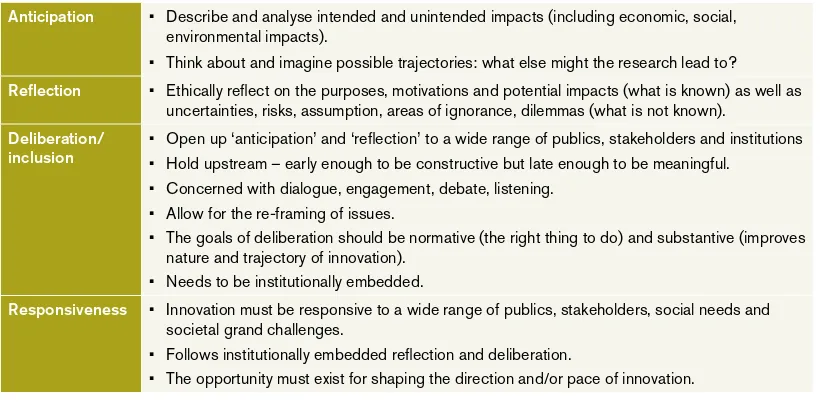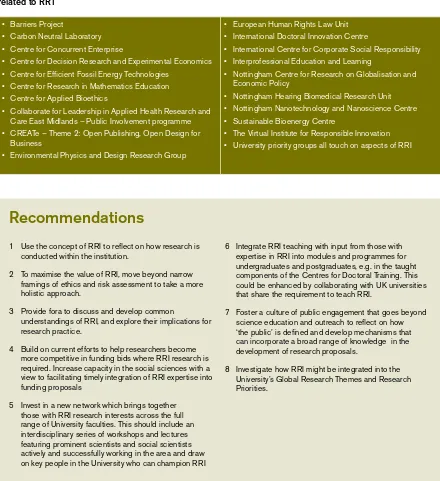Responsible Research and Innovation
Responding to the new research agenda
Responsible Research and Innovation (RRI) is concerned with the nature
and trajectory of research and innovation: what it can do for society and
who gets to decide. RRI has been embedded in key funding institutions
such as EPSRC (Engineering and Physical Sciences Research Council),
and the EU’s Horizon 2020 programme and in major funding calls from
other organisations. As RRI has emerged, it has been addressed in an
ad hoc manner by individual projects within The University of Nottingham,
such as the Synthetic Biology Research Centre and the Centre for
Doctoral Training in Sustainable Chemistry.
This report provides an overview of RRI, breaking down the concept
into four dimensions, laying out approaches from key funders, strands of
existing work at the University and recommendations for addressing the
challenges which RRI presents. The report is one output of a research
project using documentary analysis and interviews to investigate how RRI
is being interpreted within a research-intensive, Russell Group university.
The project is an interdisciplinary collaboration between the Schools of
Biosciences, Chemistry and Sociology and Social Policy, funded by the
University’s Bridging the Gaps initiative.
Introduction
INTRODUC
TION
W
HA
T I
S R
R
I?
2 Responsible Research and Innovation
Anticipation • Describe and analyse intended and unintended impacts (including economic, social, environmental impacts).
• Think about and imagine possible trajectories: what else might the research lead to?
Reflection • Ethically reflect on the purposes, motivations and potential impacts (what is known) as well as uncertainties, risks, assumption, areas of ignorance, dilemmas (what is not known).
Deliberation/
inclusion • Open up ‘anticipation’ and ‘reflection’ to a wide range of publics, stakeholders and institutions• Hold upstream – early enough to be constructive but late enough to be meaningful. • Concerned with dialogue, engagement, debate, listening.
• Allow for the re-framing of issues.
• The goals of deliberation should be normative (the right thing to do) and substantive (improves nature and trajectory of innovation).
• Needs to be institutionally embedded.
Responsiveness • Innovation must be responsive to a wide range of publics, stakeholders, social needs and societal grand challenges.
• Follows institutionally embedded reflection and deliberation.
• The opportunity must exist for shaping the direction and/or pace of innovation.
In the UK, the EPSRC has institutionalised RRI into its strategic thinking and funding programmes, translating the four dimensions into ‘anticipate, reflect, engage, act’ (AREA). The EPSRC expects researchers to demonstrate a commitment to RRI and encourages funding applications that address the concept by incorporating social scientists with relevant experience as an integral part of research projects.
The BBSRC (Biotechnology and Biological Sciences Research Council) has not yet institutionalised RRI into governance structures, but incorporates it into certain funding calls. For example, its synthetic biology research centres (including that awarded to the University) were encouraged to integrate experimental scientists and social scientists ‘within the context of responsible innovation’.
At the European level, RRI is incorporated into Horizon2020 through its ‘Science with and for Society’ pillar (estimated budget €109m for 2014/5). The calls and actions in this pillar are targeted to develop RRI across the EU in reference to six keys which is claimed will better align the process and outcomes of research and innovation with the values, needs and expectations of European society. These keys are public engagement, gender equality, science education, ethics, open access and governance.
RRI is also featured as an integrated component of science and engineering pillars within Horizon2020, and has already featured in calls for nanotechnology and synthetic biology.
What is Responsible Research and Innovation?
The institutionalisation of RRI in UK and EU funding bodies
RRI is a relatively new concept receiving increased attentionfrom academics and funders within Europe. As it has
developed, RRI has been formalised into four dimensions which provide a practical framework for the conceptualisation, design and undertaking of research and innovation.
Each of the dimensions is the responsibility of scientists, universities, research funders, regulators, businesses, and science governance institutions.
Responsible Research and Innovation 3
Authors:
[image:2.1191.664.1074.309.510.2]Warren Pearce
Sarah Hartley
Alasdair Taylor
Table 1. The four dimensions of Responsible Research and Innovation (Owen et al, 2013.)
FIND
IN
GS
RE
C
O
MMEND
AT
IO
NS
Findings
1 The UK Research Councils have incorporated RRI into governance frameworks and funding calls and the European Commission has incorporated RRI into the EU Framework Programme for Research and Innovation, Horizon 2020. Significant funding opportunities exist for RRI, particularly within the sciences and engineering.
2 RRI has the potential to include a broader range of public values in research and innovation beyond those underpinning economic growth.
3 The University does not address RRI within its governance framework.
4 University researchers respond to funders’ RRI requirements in an ad hoc manner.
5 Integration of RRI in research projects and programmes is influenced by a number of factors, which require further research. Our initial findings suggest the following areas for investigation:
a Availability of RRI expertise within the social sciences, particularly at senior levels.
b How and when RRI is integrated into research proposals. c The presence of multi-disciplinary networks.
d The role of key individuals who champion RRI.
6 A number of existing research activities in the University explicitly engage with RRI – see below. There are key people in the University who are well-positioned to champion RRI.
7 Some research centres, projects and programmes have activities which relate to elements of RRI – see Table 2. 8 Over 30 individual members of staff have an interest in RRI
across the University but, for the most part, these individuals are not well connected with each other or aware of each other’s interests.
9 Interviews with key University staff reveal diverse
interpretations of RRI, ranging from narrow framings around ethics and risk assessment to broader framings that address the nature and trajectory of research and innovation. 10 EPSRC’s RRI framework is closely related to the academic
literature, taking a more holistic approach as to how it can shape research and innovation. In contrast, in Horizon 2020, RRI is more closely aligned to the programme’s broader economic and innovation goals.
• Barriers Project
• Carbon Neutral Laboratory • Centre for Concurrent Enterprise
• Centre for Decision Research and Experimental Economics • Centre for Efficient Fossil Energy Technologies
• Centre for Research in Mathematics Education • Centre for Applied Bioethics
• Collaborate for Leadership in Applied Health Research and Care East Midlands – Public Involvement programme • CREATe – Theme 2: Open Publishing, Open Design for
Business
• Environmental Physics and Design Research Group
• European Human Rights Law Unit • International Doctoral Innovation Centre
• International Centre for Corporate Social Responsibility • Interprofessional Education and Learning
• Nottingham Centre for Research on Globalisation and Economic Policy
• Nottingham Hearing Biomedical Research Unit • Nottingham Nanotechnology and Nanoscience Centre • Sustainable Bioenergy Centre
[image:3.1191.667.1107.223.704.2]• The Virtual Institute for Responsible Innovation • University priority groups all touch on aspects of RRI
Table 2. Identified University research groups, centres and consortia with research projects or programmes related to RRI
1 Use the concept of RRI to reflect on how research is conducted within the institution.
2 To maximise the value of RRI, move beyond narrow framings of ethics and risk assessment to take a more holistic approach.
3 Provide fora to discuss and develop common
understandings of RRI, and explore their implications for research practice.
4 Build on current efforts to help researchers become more competitive in funding bids where RRI research is required. Increase capacity in the social sciences with a view to facilitating timely integration of RRI expertise into funding proposals
5 Invest in a new network which brings together those with RRI research interests across the full range of University faculties. This should include an interdisciplinary series of workshops and lectures featuring prominent scientists and social scientists actively and successfully working in the area and draw on key people in the University who can champion RRI
6 Integrate RRI teaching with input from those with expertise in RRI into modules and programmes for undergraduates and postgraduates, e.g. in the taught components of the Centres for Doctoral Training. This could be enhanced by collaborating with UK universities that share the requirement to teach RRI.
7 Foster a culture of public engagement that goes beyond science education and outreach to reflect on how ‘the public’ is defined and develop mechanisms that can incorporate a broad range of knowledge in the development of research proposals.
8 Investigate how RRI might be integrated into the University’s Global Research Themes and Research Priorities.
Recommendations
4 Responsible Research and Innovation Responsible Research and Innovation 5
• Centre for Doctoral Training in Sustainable Chemistry: core training component.
• Synthetic Biology Research Centre: integrated research theme.
• Institute for Science and Society and Science, Technology and Society Priority Group: ongoing research theme and interest.
• Horizon Digital Economy Research: expertise in RRI in information and communications technology.
• Making Science Public programme: Publics and the Making of Socially Responsible Research and Innovation.
• Responsible Research and Innovation: Challenges and Opportunities for Governance: University of Nottingham project.
For more extensive references, commentary and weblinks, go to: nott.ac.uk/rrihub
RRI Information Hub
FU
RTH
E
R I
N
FOR
MA
TION
Macnaghten, P. et al (2014).
Responsible innovation across borders: tensions, paradoxes and possibilities, Journal of Responsible Innovation, 1(2): 191-199
Stilgoe, J., Owen, R., & Macnaghten, P. (2013). Developing a framework for responsible innovation. Research Policy, 42(9), 1568-1580.
Owen, R., Bessant, J., & Heintz, M. (Eds.). (2013). Responsible innovation: managing the responsible emergence of science and innovation in society. John Wiley & Sons.
Further reading
Lead researchers
Warren Pearce
School of Sociology and Social Policy e: warren.pearce@nottingham.ac.uk
@WarrenPearce
Sarah Hartley
School of Biosciences
e: sarah.hartley@nottingham.ac.uk
@Sarah_A_Hartley
Alasdair Taylor
School of Chemistry
e: alasdair.taylor@nottingham.ac.uk
@AWTaylor83
Research assistant
Penny Polson
Research team
6 Responsible Research and Innovation Responsible Research and Innovation 7
If you require this publication in an
alternative format, please contact us.
t: +44 (0)115 951 4591
e: alternativeformats@nottingham.ac.uk
The University of Nottingham has made every effort to ensure that the information in this guide was accurate when published. Please note, however, that the nature of the content means that it is subject to change from time-to-time, and you should therefore consider the information to be guiding rather than definitive. Printed August 2014. © The University of Nottingham.
8 The Centre of Evidence Based Dermatology www.nottingham.ac.uk/dermatology

